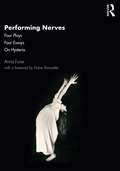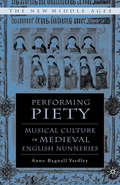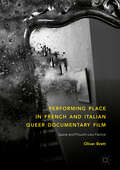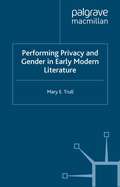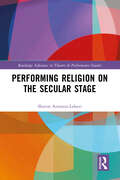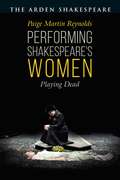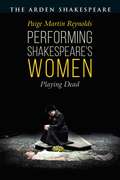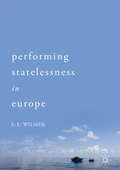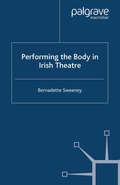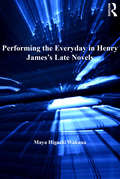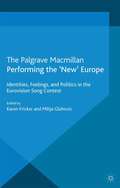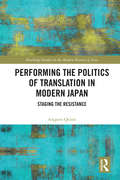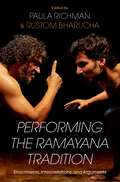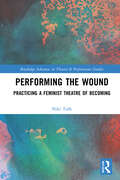- Table View
- List View
Performing Nerves: Four Plays, Four Essays, On Hysteria
by Anna FurseAcademic interest in hysteria has burgeoned in recent decades. The topic has been probed by feminist theorists, cultural studies specialists, literary scholars, anthropologists, sociologists, psychologists, medical and art historians, as well as novelists. The hysteric is construed as a powerless, voiceless subject, marginalised by the forces of the patriarchy that have been the root cause of their distress, dissembling, and disablement. In Performing Nerves, Anna Furse interweaves her artistic and academic practice, drawing on her own performance texts to explore four different versions of debilitating hysteric suffering. Each text is extensively annotated, revealing the dramaturgical logic and, in turn, the historical, medical, and cultural contexts behind their protagonists' illnesses, which are argued as environmentally caused in each case. This unique, reflective insight into a playwright and director’s craft offers not only an account of how mental suffering can manifest in different contexts and times, from the 19th century to today, but also a breadth of access to the ideas that can motivate creative research. This book is an invaluable resource for scholars of theatre studies, performance studies, dramaturgy, 20th-century history, gender studies, and medical humanities.
Performing Nerves: Four Plays, Four Essays, On Hysteria
by Anna FurseAcademic interest in hysteria has burgeoned in recent decades. The topic has been probed by feminist theorists, cultural studies specialists, literary scholars, anthropologists, sociologists, psychologists, medical and art historians, as well as novelists. The hysteric is construed as a powerless, voiceless subject, marginalised by the forces of the patriarchy that have been the root cause of their distress, dissembling, and disablement. In Performing Nerves, Anna Furse interweaves her artistic and academic practice, drawing on her own performance texts to explore four different versions of debilitating hysteric suffering. Each text is extensively annotated, revealing the dramaturgical logic and, in turn, the historical, medical, and cultural contexts behind their protagonists' illnesses, which are argued as environmentally caused in each case. This unique, reflective insight into a playwright and director’s craft offers not only an account of how mental suffering can manifest in different contexts and times, from the 19th century to today, but also a breadth of access to the ideas that can motivate creative research. This book is an invaluable resource for scholars of theatre studies, performance studies, dramaturgy, 20th-century history, gender studies, and medical humanities.
Performing Piety: Musical Culture in Medieval English Nunneries (The New Middle Ages)
by A. YardleyAddressing questions about the musical life in English nunneries in the later Middle Ages, Yardley pieces together a mosaic of nunnery musical life, where even the smallest convents sang the monastic offices on a daily basis and many of the larger houses celebrated the late medieval liturgy in all of its complexity.
Performing Place in French and Italian Queer Documentary Film: Space and Proust's Lieu Factice
by Oliver BrettThis book explores the space of queer documentary through the modernist optic of Marcel Proust’s ‘lieu factice’ (artificial place), a perspective that problematizes the location of place in a post-postmodern world with a dispersed sense of the real. The practice of queer documentary in France and Italy, from the beginning of the new millennium onwards, is seen to re-write the coherence of ‘place’ through a range of emerging queer realities. Proposing the post-queer as a way of contending with the spatial dynamics of these contexts, analysis of key texts positions place as mourned, conceded and intersectional. The performance of place as agency is considered through the notional film, the radical archive of documentary, the enactment of politics, queer indeterminacy and a phenomenology of the object, the frame and queer mobility. The central themes of family, gender, dis/location, in/visibility and re/presentation question blind investment in the integrity of being emplaced.
Performing Politics: Media Interviews, Debates and Press Conferences (Contemporary Political Communication)
by Geoffrey CraigFor successful political leaders, public speaking is only half the battle. A good politician must also be a competent performer. Whether facing critical questions in an interview, posturing in a leaders’ debate, or conversing on a daytime chat show, success is reliant upon a candidate’s ability to dramatically but authentically impart a strong individual identity. In this innovative analysis, Geoffrey Craig looks at the interrogative exchanges between politicians and journalists. The power struggles and evasions in these encounters often leave the public exasperated, but it is the politicians’ negotiation of these struggles that determines success. Drawing on analyses of the language and performances of leaders such as Barack Obama and David Cameron, Craig examines the particular kinds of interactions that occur across political interviews, debates, conferences, and talk shows. The political games that take place between politicians and journalists, he argues, constitute the true theatre of politics. Engaging and insightful, Performing Politics will appeal to students and scholars of journalism, politics, linguistics, and media studies, as well as anyone concerned about the quality of contemporary political communication.
Performing Privacy and Gender in Early Modern Literature (Early Modern Literature in History)
by M. TrullThis book argues that the early modern public/private boundary was surprisingly dynamic and flexible in early modern literature, drawing upon authors including Shakespeare, Anne Lock, Mary Wroth, and Aphra Behn, and genres including lyric poetry, drama, prose fiction, and household orders. An epilogue discusses postmodern privacy in digital media.
Performing Religion on the Secular Stage (Routledge Advances in Theatre & Performance Studies)
by Sharon Aronson-LehaviThis book examines the relations between Western religion, secularism, and modern theater and performance. Sharon Aronson-Lehavi posits that the ongoing cultural power of religious texts, icons, and ideas on the one hand and the artistic freedom enabled by secularism and avant-garde experimentalism on the other, has led theatre artists throughout the twentieth century to create a uniquely modern theatrical hybrid–theater performances that simultaneously re-inscribe and grapple with religion and religious performativity. The book compares this phenomenon with medieval forms of religious theater and offers deep and original analyses of significant contemporary works ranging from plays and performances by August Strindberg, Hugo Ball (Dada), Jerzy Grotowski, and Hanoch Levin, to those created by Adrienne Kennedy, Rina Yerushalmi, Deb Margolin, Milo Rau, and Sarah Ruhl. The book analyzes a new and original historiography of a uniquely modern theatrical phenomenon, a study that is of high importance considering the reemergence of religion in contemporary culture and politics.
Performing Religion on the Secular Stage (Routledge Advances in Theatre & Performance Studies)
by Sharon Aronson-LehaviThis book examines the relations between Western religion, secularism, and modern theater and performance. Sharon Aronson-Lehavi posits that the ongoing cultural power of religious texts, icons, and ideas on the one hand and the artistic freedom enabled by secularism and avant-garde experimentalism on the other, has led theatre artists throughout the twentieth century to create a uniquely modern theatrical hybrid–theater performances that simultaneously re-inscribe and grapple with religion and religious performativity. The book compares this phenomenon with medieval forms of religious theater and offers deep and original analyses of significant contemporary works ranging from plays and performances by August Strindberg, Hugo Ball (Dada), Jerzy Grotowski, and Hanoch Levin, to those created by Adrienne Kennedy, Rina Yerushalmi, Deb Margolin, Milo Rau, and Sarah Ruhl. The book analyzes a new and original historiography of a uniquely modern theatrical phenomenon, a study that is of high importance considering the reemergence of religion in contemporary culture and politics.
Performing Shakespeare's Women: Playing Dead
by Dr Paige Martin ReynoldsShakespeare's women rarely reach the end of the play alive. Whether by murder or by suicide, onstage or off, female actors in Shakespeare's works often find themselves 'playing dead.' But what does it mean to 'play dead', particularly for women actors, whose bodies become scrutinized and anatomized by audiences and fellow actors who 'grossly gape on'? In what ways does playing Shakespeare's women when they are dead emblematize the difficulties of playing them while they are still alive? Ultimately, what is at stake for the female actor who embodies Shakespeare's women today, dead or alive? Situated at the intersection of the creative and the critical, Performing Shakespeare's Women: Playing Dead engages performance history, current scholarship and the practical problems facing the female actor of Shakespeare's plays when it comes to 'playing dead' on the contemporary stage and in a post-feminist world. This book explores the consequences of corpsing Shakespeare's women, considering important ethical questions that matter to practitioners, students and critics of Shakespeare today.
Performing Shakespeare's Women: Playing Dead
by Dr Paige Martin ReynoldsShakespeare's women rarely reach the end of the play alive. Whether by murder or by suicide, onstage or off, female actors in Shakespeare's works often find themselves 'playing dead.' But what does it mean to 'play dead', particularly for women actors, whose bodies become scrutinized and anatomized by audiences and fellow actors who 'grossly gape on'? In what ways does playing Shakespeare's women when they are dead emblematize the difficulties of playing them while they are still alive? Ultimately, what is at stake for the female actor who embodies Shakespeare's women today, dead or alive? Situated at the intersection of the creative and the critical, Performing Shakespeare's Women: Playing Dead engages performance history, current scholarship and the practical problems facing the female actor of Shakespeare's plays when it comes to 'playing dead' on the contemporary stage and in a post-feminist world. This book explores the consequences of corpsing Shakespeare's women, considering important ethical questions that matter to practitioners, students and critics of Shakespeare today.
Performing Statelessness in Europe
by S. E. WilmerThis book examines performative strategies that contest nationalist prejudices in representing the conditions of refugees, the stateless and the dispossessed. In the light of the European Union failing to find a political solution to the current migration crisis, it considers a variety of artistic works that have challenged the deficiencies in governmental and transnational practices, as well as innovative efforts by migrants and their hosts to imagine and build a new future. It discusses a diverse range of performative strategies, moving from a consideration of recent adaptations of Greek tragedy, to performances employing fictive identification, documentary dramas, immersive theatre, over-identification and subversive identification, nomadism and political activism. This study will appeal to those interested in questions of statelessness, migration, and the problematic role of the nation-state.
Performing Statelessness in Europe
by S. E. WilmerThis book examines performative strategies that contest nationalist prejudices in representing the conditions of refugees, the stateless and the dispossessed. In the light of the European Union failing to find a political solution to the current migration crisis, it considers a variety of artistic works that have challenged the deficiencies in governmental and transnational practices, as well as innovative efforts by migrants and their hosts to imagine and build a new future. It discusses a diverse range of performative strategies, moving from a consideration of recent adaptations of Greek tragedy, to performances employing fictive identification, documentary dramas, immersive theatre, over-identification and subversive identification, nomadism and political activism. This study will appeal to those interested in questions of statelessness, migration, and the problematic role of the nation-state.
Performing the Body in Irish Theatre
by B. SweeneyThis title examines the representation of the body in Irish theatre alongside the specific circumstances within which Irish theatre is performed, incorporating issues of gender and embodiment, and the performance of Irishness and tradition. The author contextualizes the body in Irish theatre, and includes in-depth analysis of five key productions.
Performing the Everyday in Henry James's Late Novels
by Maya Higashi WakanaFocusing on James's last three completed novels - The Ambassadors, The Wings of the Dove, and The Golden Bowl - Maya Higashi Wakana shows how a microsociological approach to James's novels radically revises the widespread tradition of putting James's characters into historical and cultural contexts. Wakana begins with the premise that day-to-day living is inherently theatrical and thus duplicitous, and goes on to show that James's art relies significantly on his powerful sense of the agonizing and even dangerous complications of mundane face-to-face rituals that pervade his work. Centrally informed by social thinkers such as G. H. Mead and Erving Goffman, Wakana's study discloses the richness, complexity, and singularity of the interpersonal connections depicted in James's late novels. Persuasively argued, and rich in original close readings, her book makes an important contribution to James's studies and to theories of social interaction.
Performing the Everyday in Henry James's Late Novels
by Maya Higashi WakanaFocusing on James's last three completed novels - The Ambassadors, The Wings of the Dove, and The Golden Bowl - Maya Higashi Wakana shows how a microsociological approach to James's novels radically revises the widespread tradition of putting James's characters into historical and cultural contexts. Wakana begins with the premise that day-to-day living is inherently theatrical and thus duplicitous, and goes on to show that James's art relies significantly on his powerful sense of the agonizing and even dangerous complications of mundane face-to-face rituals that pervade his work. Centrally informed by social thinkers such as G. H. Mead and Erving Goffman, Wakana's study discloses the richness, complexity, and singularity of the interpersonal connections depicted in James's late novels. Persuasively argued, and rich in original close readings, her book makes an important contribution to James's studies and to theories of social interaction.
Performing the 'New' Europe: Identities, Feelings and Politics in the Eurovision Song Contest (Studies in International Performance)
by Karen Fricker and Milija GluhovicThis fascinating and lively volume makes the case that the Eurovision Song Contest is an arena for European identification in which both national solidarity and participation in a European identity are confirmed, and a site where cultural struggles over the meanings, frontiers and limits of Europe are enacted.
Performing the Past: A Study of Israeli Settlement Museums (Everyday Communication Series)
by Tamar KatrielA nostalgic interest in the past is a well-recognized feature of fast-changing, contemporary societies. It finds its expression in a variety of history-making practices of which the establishment of local heritage museums is a major manifestation in many parts of the world today. Katriel develops a communication-centered perspective on the study of heritage museums and -- by extension -- other tourist sites, highlighting the role of discourse in these institutionalized, yet vernacular contexts of cultural production, social legitimation, and identity formation. Descriptive and critical in orientation, this book combines a close analysis of museum discourse with an exploration of such larger issues as: * the socio-cultural role of museums as arenas for the production of collective memory, * the ideological and performative constraints that shape museum presentations, * the interfacing of verbal and visual codes of communication in the context of material displays, * the dialectical interplay of the local and the global in contemporary life, and * the interpenetration of the personal and the communal in vernacular processes of narrative production. Of interest to scholars in communication, linguistics, anthropology, history, museum studies, tourism, intercultural communication, middle eastern studies, or those with interests in narratives, material culture, and ethnography.
Performing the Past: A Study of Israeli Settlement Museums (Everyday Communication Series)
by Tamar KatrielA nostalgic interest in the past is a well-recognized feature of fast-changing, contemporary societies. It finds its expression in a variety of history-making practices of which the establishment of local heritage museums is a major manifestation in many parts of the world today. Katriel develops a communication-centered perspective on the study of heritage museums and -- by extension -- other tourist sites, highlighting the role of discourse in these institutionalized, yet vernacular contexts of cultural production, social legitimation, and identity formation. Descriptive and critical in orientation, this book combines a close analysis of museum discourse with an exploration of such larger issues as: * the socio-cultural role of museums as arenas for the production of collective memory, * the ideological and performative constraints that shape museum presentations, * the interfacing of verbal and visual codes of communication in the context of material displays, * the dialectical interplay of the local and the global in contemporary life, and * the interpenetration of the personal and the communal in vernacular processes of narrative production. Of interest to scholars in communication, linguistics, anthropology, history, museum studies, tourism, intercultural communication, middle eastern studies, or those with interests in narratives, material culture, and ethnography.
Performing the Politics of Translation in Modern Japan: Staging the Resistance (Routledge Studies in the Modern History of Asia)
by Aragorn QuinnPerforming the Politics of Translation in Modern Japan sheds new light on the adoption of concepts that motivated political theatres of resistance for nearly a century and even now underpin the collective understanding of the Japanese nation. Grounded in the aftermath of the Meiji Restoration in 1868 and analyzing its legacy on stage, this book tells the story of the crucial role that performance and specifically embodied memory played in the changing understanding of the imported Western concepts of "liberty" (jiyū) and "revolution" (kakumei). Tracing the role of the post-Restoration movement itself as an important touchstone for later performances, it examines two key moments of political crisis. The first of these is the Proletarian Theatre Movement of the 1920s and '30s, in which the post-Restoration years were important for theorizing the Japanese communist revolution. The second is in the postwar years when Rights Movement theatre and thought again featured as a vehicle for understanding the present through the past. As such, this book presents the translation of "liberty" and "revolution", not through a one-to-one correspondence model, but rather as a many-to-many relationship. In doing so, it presents a century of evolution in the dramaturgy of resistance in Japan. This book will be useful to students and scholars of Japanese history, society and culture, as well as literature and translation studies alike.
Performing the Politics of Translation in Modern Japan: Staging the Resistance (Routledge Studies in the Modern History of Asia)
by Aragorn QuinnPerforming the Politics of Translation in Modern Japan sheds new light on the adoption of concepts that motivated political theatres of resistance for nearly a century and even now underpin the collective understanding of the Japanese nation. Grounded in the aftermath of the Meiji Restoration in 1868 and analyzing its legacy on stage, this book tells the story of the crucial role that performance and specifically embodied memory played in the changing understanding of the imported Western concepts of "liberty" (jiyū) and "revolution" (kakumei). Tracing the role of the post-Restoration movement itself as an important touchstone for later performances, it examines two key moments of political crisis. The first of these is the Proletarian Theatre Movement of the 1920s and '30s, in which the post-Restoration years were important for theorizing the Japanese communist revolution. The second is in the postwar years when Rights Movement theatre and thought again featured as a vehicle for understanding the present through the past. As such, this book presents the translation of "liberty" and "revolution", not through a one-to-one correspondence model, but rather as a many-to-many relationship. In doing so, it presents a century of evolution in the dramaturgy of resistance in Japan. This book will be useful to students and scholars of Japanese history, society and culture, as well as literature and translation studies alike.
Performing the Ramayana Tradition: Enactments, Interpretations, and Arguments
by Paula Richman and Rustom BharuchaThe Ramayana, one of the two pre-eminent Hindu epics, has played a foundational role in many aspects of India's arts and social norms. For centuries, people learned this narrative by watching, listening, and participating in enactments of it. Although the Ramayana's first extant telling in Sanskrit dates back to ancient times, the story has continued to be retold and rethought through the centuries in many of India's regional languages, such as Hindi, Tamil, and Bengali. The narrative has provided the basis for enactments of its episodes in recitation, musical renditions, dance, and avant-garde performances. This volume introduces non-specialists to the Ramayana's major themes and complexities, as well as to the highly nuanced terms in Indian languages used to represent theater and performance. Two introductions orient readers to the history of Ramayana texts by Tulsidas, Valmiki, Kamban, Sankaradeva, and others, as well as to the dramaturgy and aesthetics of their enactments. The contributed essays provide context-specific analyses of diverse Ramayana performance traditions and the narratives from which they draw. The essays are clustered around the shared themes of the politics of caste and gender; the representation of the anti-hero; contemporary re-interpretations of traditional narratives; and the presence of Ramayana discourse in daily life.
Performing the Ramayana Tradition: Enactments, Interpretations, and Arguments
The Ramayana, one of the two pre-eminent Hindu epics, has played a foundational role in many aspects of India's arts and social norms. For centuries, people learned this narrative by watching, listening, and participating in enactments of it. Although the Ramayana's first extant telling in Sanskrit dates back to ancient times, the story has continued to be retold and rethought through the centuries in many of India's regional languages, such as Hindi, Tamil, and Bengali. The narrative has provided the basis for enactments of its episodes in recitation, musical renditions, dance, and avant-garde performances. This volume introduces non-specialists to the Ramayana's major themes and complexities, as well as to the highly nuanced terms in Indian languages used to represent theater and performance. Two introductions orient readers to the history of Ramayana texts by Tulsidas, Valmiki, Kamban, Sankaradeva, and others, as well as to the dramaturgy and aesthetics of their enactments. The contributed essays provide context-specific analyses of diverse Ramayana performance traditions and the narratives from which they draw. The essays are clustered around the shared themes of the politics of caste and gender; the representation of the anti-hero; contemporary re-interpretations of traditional narratives; and the presence of Ramayana discourse in daily life.
Performing the Wound: Practicing a Feminist Theatre of Becoming (Routledge Advances in Theatre & Performance Studies)
by Niki TulkThis book offers a matrixial, feminist-centered analysis of trauma and performance, through examining the work of three artists: Ann Hamilton, Renée Green, and Cecilia Vicuña. Each artist engages in a multi-media, or “combination” performance practice; this includes the use of site, embodied performance, material elements, film, and writing. Each case study involves traumatic content, including the legacy of slavery, child sexual abuse and environmental degradation; each artist constructs an aesthetic milieu that invites rather than immerses—this allows an audience to have agency, as well as multiple pathways into their engagement with the art. The author Niki Tulk suggests that these works facilitate an audience-performance relationship based on the concept of ethical witnessing/wit(h)nessing, in which viewers are not positioned as voyeurs, nor made to risk re-traumatization by being forced to view traumatic events re-played on stage. This approach also allows agency to the art itself, in that an ethical space is created where the art is not objectified or looked at—but joined with. Foundational to this investigation are the writings of Bracha L. Ettinger, Jill Bennett and Diana Taylor—particularly Ettinger’s concepts of the matrixial, carriance and border-linking. These artists and scholars present a capacity to expand and articulate answers to questions regarding how to make performance that remains compelling and truthful to the trauma experience, but not re-traumatizing. This study will be of great interest to students and scholars of performance studies, art history, visual arts, feminist studies, theatre, film, performance art, postcolonialism, rhetoric and writing.
Performing the Wound: Practicing a Feminist Theatre of Becoming (Routledge Advances in Theatre & Performance Studies)
by Niki TulkThis book offers a matrixial, feminist-centered analysis of trauma and performance, through examining the work of three artists: Ann Hamilton, Renée Green, and Cecilia Vicuña. Each artist engages in a multi-media, or “combination” performance practice; this includes the use of site, embodied performance, material elements, film, and writing. Each case study involves traumatic content, including the legacy of slavery, child sexual abuse and environmental degradation; each artist constructs an aesthetic milieu that invites rather than immerses—this allows an audience to have agency, as well as multiple pathways into their engagement with the art. The author Niki Tulk suggests that these works facilitate an audience-performance relationship based on the concept of ethical witnessing/wit(h)nessing, in which viewers are not positioned as voyeurs, nor made to risk re-traumatization by being forced to view traumatic events re-played on stage. This approach also allows agency to the art itself, in that an ethical space is created where the art is not objectified or looked at—but joined with. Foundational to this investigation are the writings of Bracha L. Ettinger, Jill Bennett and Diana Taylor—particularly Ettinger’s concepts of the matrixial, carriance and border-linking. These artists and scholars present a capacity to expand and articulate answers to questions regarding how to make performance that remains compelling and truthful to the trauma experience, but not re-traumatizing. This study will be of great interest to students and scholars of performance studies, art history, visual arts, feminist studies, theatre, film, performance art, postcolonialism, rhetoric and writing.
Performing Transversally: Reimagining Shakespeare and the Critical Future
by Bryan ReynoldsPerforming Transversally expands on Bryan Reynolds' controversial transversal theory in exciting ways while offering groundbreaking analyses of Shakespeare's plays - Hamlet , Othello , Macbeth , Taming of the Shrew , Titus Andronicus , Henry V , The Tempest , and Coriolanus - and textual, filmic, and theatrical adaptations of them. With his collaborators, Reynolds challenges traditional readings of Shakespeare, re-evaluating the critical methodologies that characterize them, in regard to issues of cultural difference, authorship, representation, agency, and iconography. Reynolds demonstrates the value of his 'investigative-expansive mode,' outlining a 'transversal poetics' that points toward a critical future that is more aware of its subjective interconnectedness with the topics and audiences it seeks to engage than is reflected in most Shakespeare criticism and literary-cultural scholarship.
